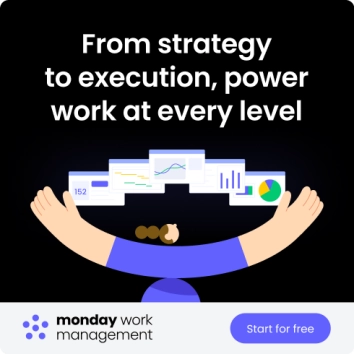IT operations teams face a constant challenge: separating critical signals from background noise. As systems scale, alerts multiply, slowing response times and straining teams. AIOps software brings intelligence to this process, analyzing data across systems to surface what matters most.
AIOps software platforms like monday service integrate AI into daily workflows so teams can predict, prevent, and resolve issues faster. This guide explains what AIOps is, why it’s essential for modern IT teams, and reviews the top platforms shaping the space in 2025.
Try monday serviceKey takeaways
- Use AI to detect issues before they disrupt critical services.
- Reduce alert fatigue with automated, intelligent event correlation.
- Connect monitoring and service workflows in one shared workspace.
- Turn data-driven insights into faster, coordinated action.
What are AIOps software solutions?
AIOps (Artificial Intelligence for IT Operations) software applies machine learning and data analytics to streamline how organizations monitor, manage, and maintain their digital systems. These platforms gather data from logs, metrics, and events across tools, clouds, and devices to spot patterns, detect anomalies, and automate responses before small issues escalate.
By centralizing data and insights, AIOps helps IT teams move from reactive incident management to proactive system optimization — reducing downtime and improving performance across the business.
Why AIOps matters for modern IT operations
As organizations adopt hybrid and multi-cloud environments, the volume of operational data continues to grow. Traditional monitoring tools struggle to process and prioritize the thousands of alerts generated each day. AIOps introduces automation and intelligence that help teams focus on what truly matters.
It enables faster detection of anomalies, earlier prediction of potential outages, and smarter resource allocation. The result is a shift from constant firefighting to strategic management — where IT becomes a driver of reliability, performance, and business continuity.
How AIOps technology works
AIOps platforms ingest and analyze data from multiple sources, such as monitoring tools, application logs, and infrastructure metrics. Machine learning models learn what “normal” performance looks like and flag deviations that could indicate emerging issues.
When anomalies are detected, the system correlates related alerts, prioritizes incidents by impact, and can trigger automated workflows for common resolutions. This combination of analytics, automation, and continuous learning helps teams respond quickly while preventing repetitive manual tasks.
AIOps delivers measurable impact across every layer of IT operations. From minimizing downtime to improving productivity, its value extends well beyond automation.
5 key benefits of AIOps platforms
- Proactive problem detection: Identify and address issues before they affect users.
- Faster incident resolution: Use automation to cut time spent on diagnostics and recovery.
- Improved service quality: Maintain uptime and reliability with predictive insights.
- Reduced manual work: Let AI handle repetitive tasks so teams can focus on higher-value work.
- Scalable intelligence: Keep pace with growing complexity without adding workload.
When applied effectively, AIOps turns operations data into actionable insight — helping teams work smarter, maintain uptime, and scale performance as environments evolve.
Top 15 AIOps software solutions for IT transformation
Navigating the AIOps market to find the ideal platform requires clarity and focus. The objective extends beyond mere technology acquisition; it is about securing a strategic partner that streamlines workflows and amplifies your team’s capabilities. An effective platform should integrate seamlessly, functioning as a force multiplier rather than an additional layer of complexity to be managed.
We’ve analyzed the market to help you discern what truly matters in an AIOps solution. From platforms that excel at predicting issues to those that master the automation of routine tasks, the right tool liberates your team to concentrate on high-impact initiatives. It’s all about converting operational data into a distinct competitive advantage.
Use this breakdown as your playbook for finding the perfect fit for your crew. We’ve highlighted each solution’s strengths, making it easy to see which platform aligns with your team’s goals and can scale with you. Let’s find the platform that will help you win.
1. monday service
monday service transforms IT operations into a proactive, intelligent service engine powered by built-in AI and no-code automation. It unifies service management across IT, HR, and facilities so teams can collaborate seamlessly, resolve issues faster, and maintain complete visibility into every workflow.

Best for: Growing organizations looking for strong ITSM plus AIOps features without heavyweight complexity.
Key features:
- AI-powered ticket classification, sentiment detection, and smart routing.
- No-code workflow builder for approvals, escalations, and custom automations.
- Real-time dashboards showing ticket backlog, agent performance, SLA (service level agreement) tracking.
- Cross-department integration: connect IT operations with HR, facilities, CRM, and asset systems.
- Built-in AI agent and automation blocks that triage and resolve routine tickets.
Pricing:
monday service offers flexible pricing plans starting at $26 per seat/month. A free trial is available and pricing scales to fit both small teams and enterprise organizations.
Why it stands out:
It delivers enterprise-grade AIOps capabilities (automatic ticket triage, smart routing, AI assistance) within a familiar service-management interface, reducing implementation friction and getting teams working faster.
Advanced AI features:
- AI Copilot delivers contextual suggestions and historical resolutions directly within ticket workflows, accelerating response times
- Intelligent ticket classification automatically detects priority, sentiment, and issue type to ensure proper routing and escalation
- Predictive analytics identify patterns and trends before they become critical issues, enabling proactive intervention
Automations:
- Smart ticket routing automatically assigns requests to the most qualified agents based on skills and current workload
- Automated SLA monitoring with intelligent escalation triggers ensures service level commitments are met consistently
- Pre-built workflow templates eliminate manual setup while allowing customization for unique organizational needs
Integrations:
- Native connections with popular tools like Outlook, Slack, Azure DevOps, and DocuSign streamline existing workflows
- CRM and employee directory integrations provide agents with complete context for personalized service delivery
- Asset management tool connectivity ensures comprehensive visibility across all organizational resources
AIOps software features:
- Real-time monitoring dashboards provide instant visibility into system performance, capacity utilization, and emerging risk areas
- Pattern recognition capabilities spot recurring issues and workflow bottlenecks, enabling teams to address root causes proactively
- Workload forecasting and trend analysis help organizations anticipate resource needs and prevent service disruptions
2. ServiceNow
ServiceNow Predictive AIOps offers advanced AIOps capabilities as part of the ServiceNow ITOM suite, applying AI and machine learning to monitor, predict, and remediate IT issues across large enterprises.
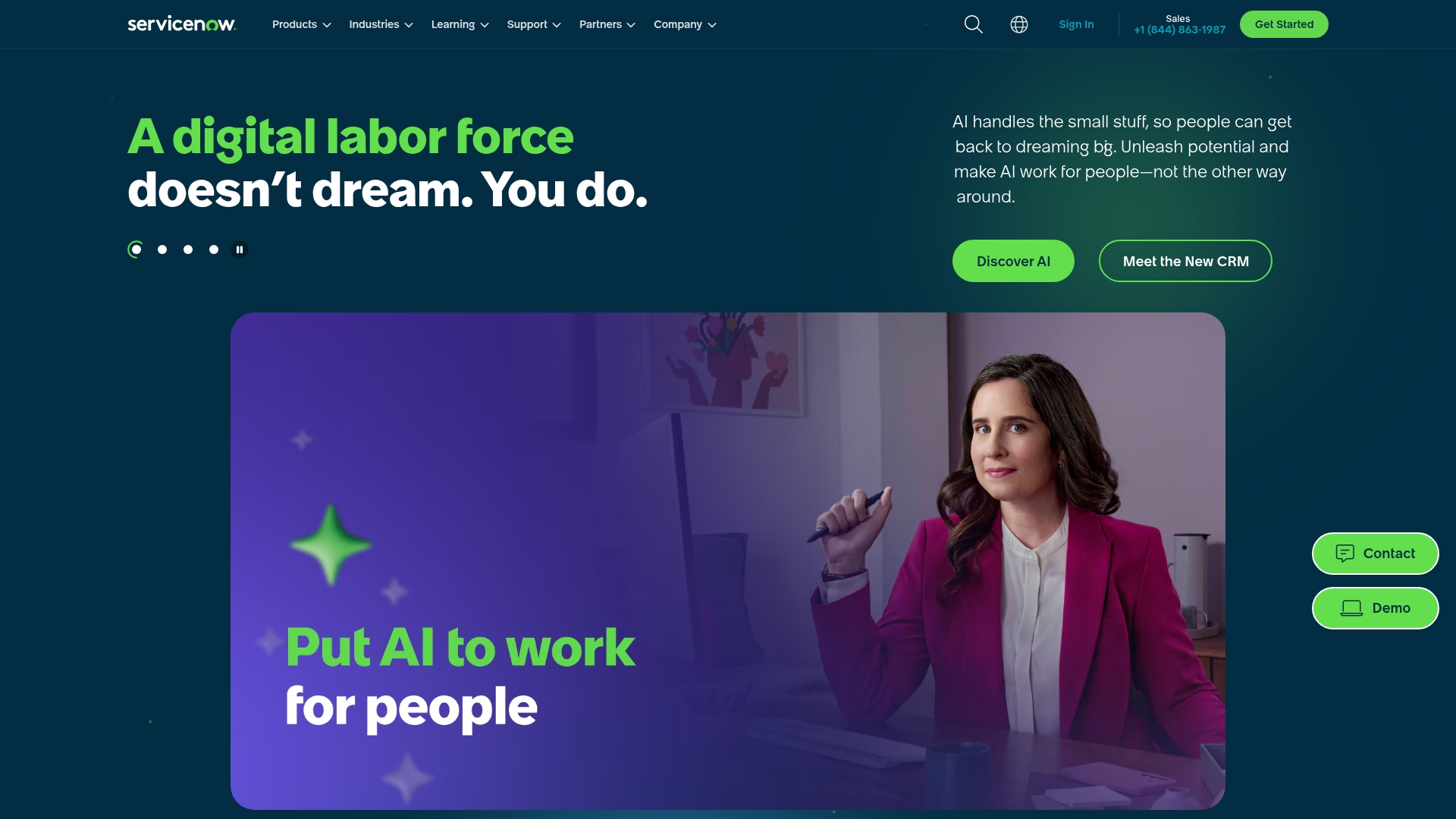
Best for: Large organizations with complex IT estates, deep ITSM maturity, and high requirements for automation and governance.
Key features:
- Data integration across logs, metrics, events, and traces.
- Anomaly detection and machine-learning triage that reduce alert noise.
- Automated remediation workflows linked to IT operations and service management.
- Service mapping and topology insight to relate incidents to business services.
Pricing:
Custom pricing. ServiceNow does not publish standard AIOps pricing; quotes depend on modules selected, user count, deployment scope and enterprise architecture.
Considerations:
- Implementation complexity can be significant; a high initial effort may be required to make full use of the platform.
- Licensing and total cost of ownership tend to be high compared to lighter-weight AIOps tools.
3. Splunk IT Service Intelligence
Splunk IT Service Intelligence (ITSI) transforms operational machine data into actionable insights, leveraging AI/ML to predict incidents and manage service health across hybrid environments.

Best for: Enterprises that already use Splunk or have heavy monitoring/log ingestion needs and want AIOps capabilities layered on top.
Key features:
- Predictive analytics and anomaly detection built on historical data and ML models.
- Event correlation and aggregation: grouping alerts into “episodes” to simplify incident management.
- Service-oriented dashboards (“Glass Tables”) that show dependencies and KPIs aligned with business services.
- Deep dive analytics — drill into logs/metrics for root-cause identification and context.
Pricing:
Pricing details are not publicly listed. Splunk uses multiple pricing models including workload-based, ingest-based, or entity-based models. Contact Splunk for custom quoting.
Considerations:
- Licensing and operational costs can become high for large volumes of data or complex deployments.
- Implementing ITSI effectively requires technical skill in Splunk, data modelling, and configuration — ramp-up time may be considerable.
4. Dynatrace
Dynatrace delivers full-stack observability and AIOps through its Davis AI engine, Smartscape topology mapping and unified data lakehouse, making it suitable for dynamic cloud-native environments.
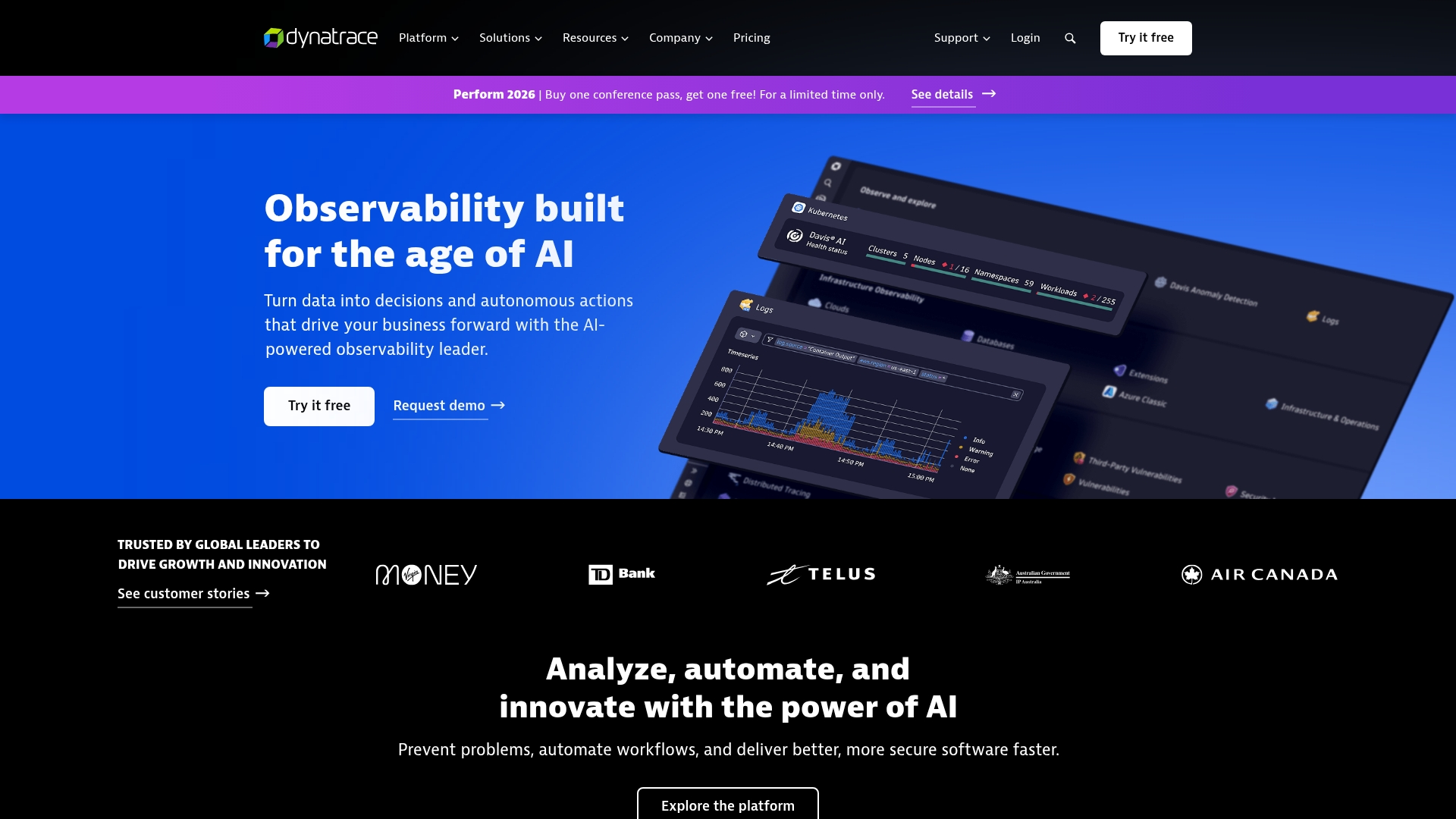
Best for: Organizations with modern, complex, multi-cloud or hybrid architectures requiring comprehensive observability and AIOps.
Key features:
- Davis AI engine that performs automated root-cause analysis across dependencies.
- Unified data lakehouse (Grail) that ingests logs, metrics, traces and events for context-rich analytics.
- Usage-based pricing with granular billing to align cost and consumption.
Pricing:
Usage-based model; for example, Full-Stack Monitoring might cost around $0.01 per GiB-hour or ~$0.04 per host-hour. Annual commitments and volume discounts apply.
Considerations:
- Higher pricing compared to competitors may not suit smaller organizations with limited budgets
- Platform complexity can present a steep learning curve for teams new to advanced observability tools
5. Moogsoft
Moogsoft (now part of Dell APEX AIOps) offers an AIOps-centric solution focused on alert noise reduction, incident correlation and automated remediation workflows tailored for DevOps/SRE teams.

Best for: Organizations with alert-heavy monitoring stacks needing to cut noise and automate incident workflows, especially SRE/DevOps teams.
Key features:
- Intelligent noise reduction and adaptive thresholding to remove non-actionable alerts.
- Anomaly detection and early incident detection before user impact.
- Root-cause analysis and event correlation across monitoring source data.
- Automated incident workflows: routing, remediation automation, third-party integrations.
Pricing:
Pricing plans start at $417/month and custom pricing for advanced plans.
Considerations:
- Complex initial setup and configuration process that can be time-consuming for new users
- Some users report concerns about customer support responsiveness, particularly for high-severity incidents
6. IBM Instana
Instana provides automated observability with AI-powered root-cause analysis and full-stack visibility across applications, services, hosts, and infrastructure. The platform suits organizations that demand immediate insight, minimal manual instrumentation, and modern observability in dynamic environments.
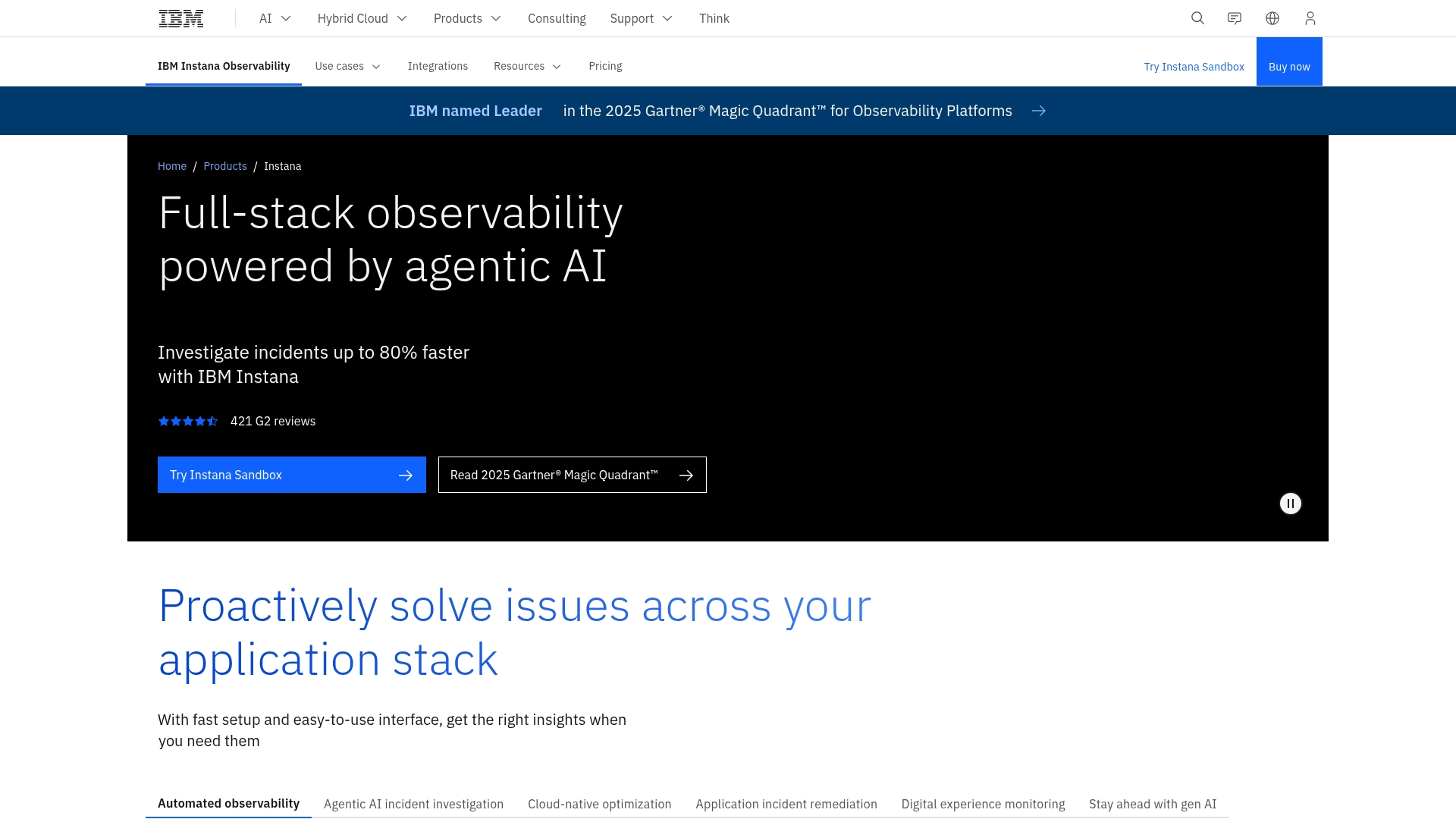
Best for: DevOps and SRE teams in medium to large enterprises managing cloud-native, microservices-driven systems.
Key features:
- Automatic discovery and mapping of services, hosts, containers, and dependencies.
- AI-driven root-cause analysis that tracks through application, infra, and service layers.
- One-second granularity metrics and full trace-capture for high fidelity monitoring.
- Flat-rate or usage-based pricing models to align cost and volume.
Pricing:
Subscriptions begin around US $18 per unit/month in some editions. Free trials are available.
Considerations:
- Complex initial setup process with a steep learning curve for teams new to application performance monitoring
- Higher cost structure that may be challenging for smaller organizations or extensive deployments
7. BMC Helix
BMC Helix AIOps delivers AI-powered service-centric monitoring, event correlation, and remediation workflows across hybrid and multi-cloud environments. It’s designed for enterprises with high IT complexity and a need to link infrastructure events to business services and outcomes.
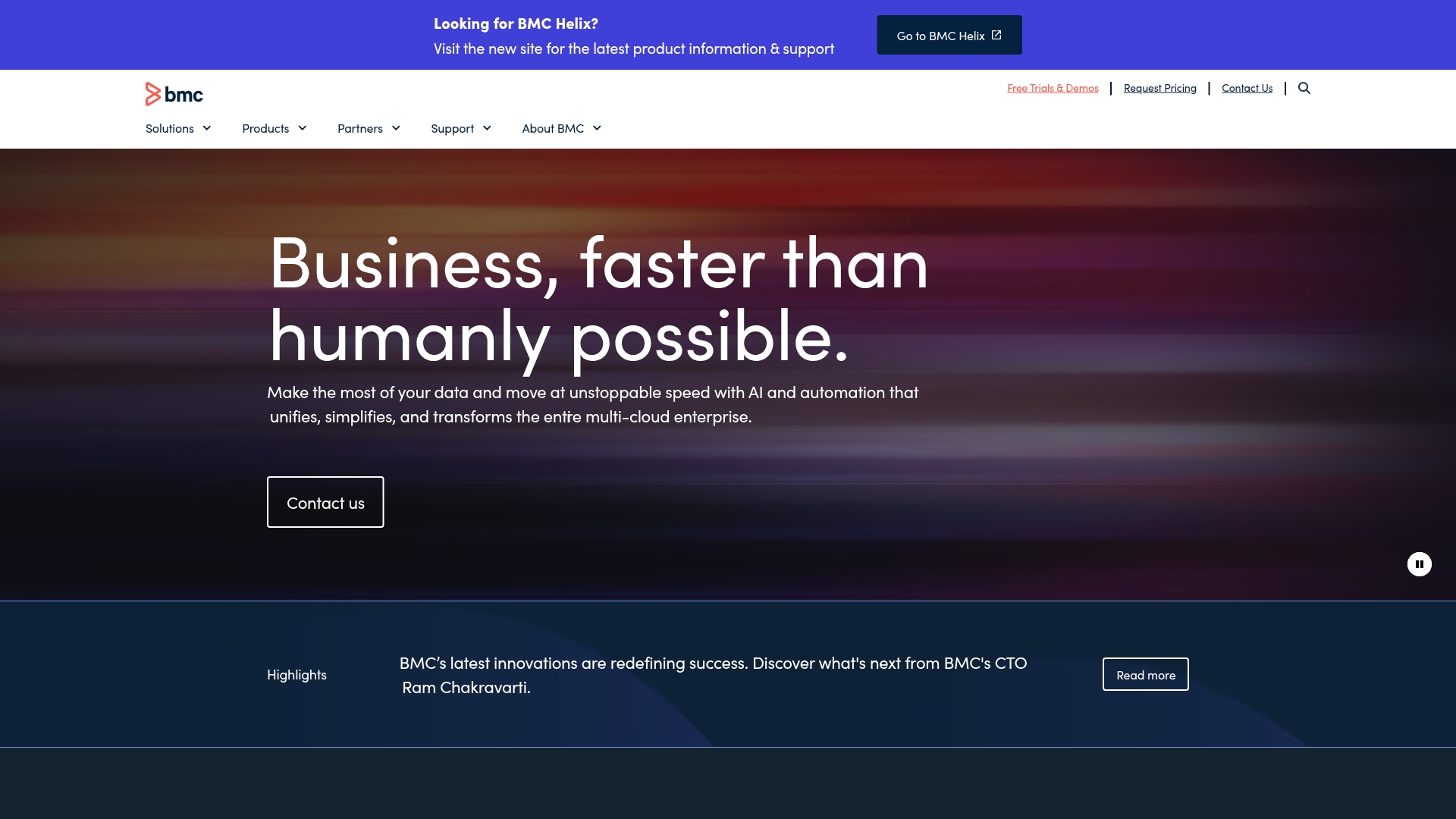
Best for: Large enterprises with mature IT operations that need a unified view across infrastructure, applications, and business services.
Key features:
- Service-centric monitoring that provides a unified view of service health and business impact
- Intelligent event clustering and noise reduction using AI/ML to group related events into “situations”
- Root cause isolation with AI-powered analysis to pinpoint exact causes and reduce mean time to resolution
Pricing:
- Contact BMC directly for custom pricing based on your specific requirements and organizational needs.
Considerations:
- Initial setup and configuration can be complex, requiring significant effort and expertise
- Platform sophistication may overwhelm organizations with lower ITSM maturity levels
8. LogicMonitor
LogicMonitor offers cloud-based infrastructure monitoring enriched with AIOps capabilities (via its “Edwin AI” agent) for hybrid and multi-cloud environments. It excels in device/discovery-based monitoring and proactive anomaly detection across large ecosystems.
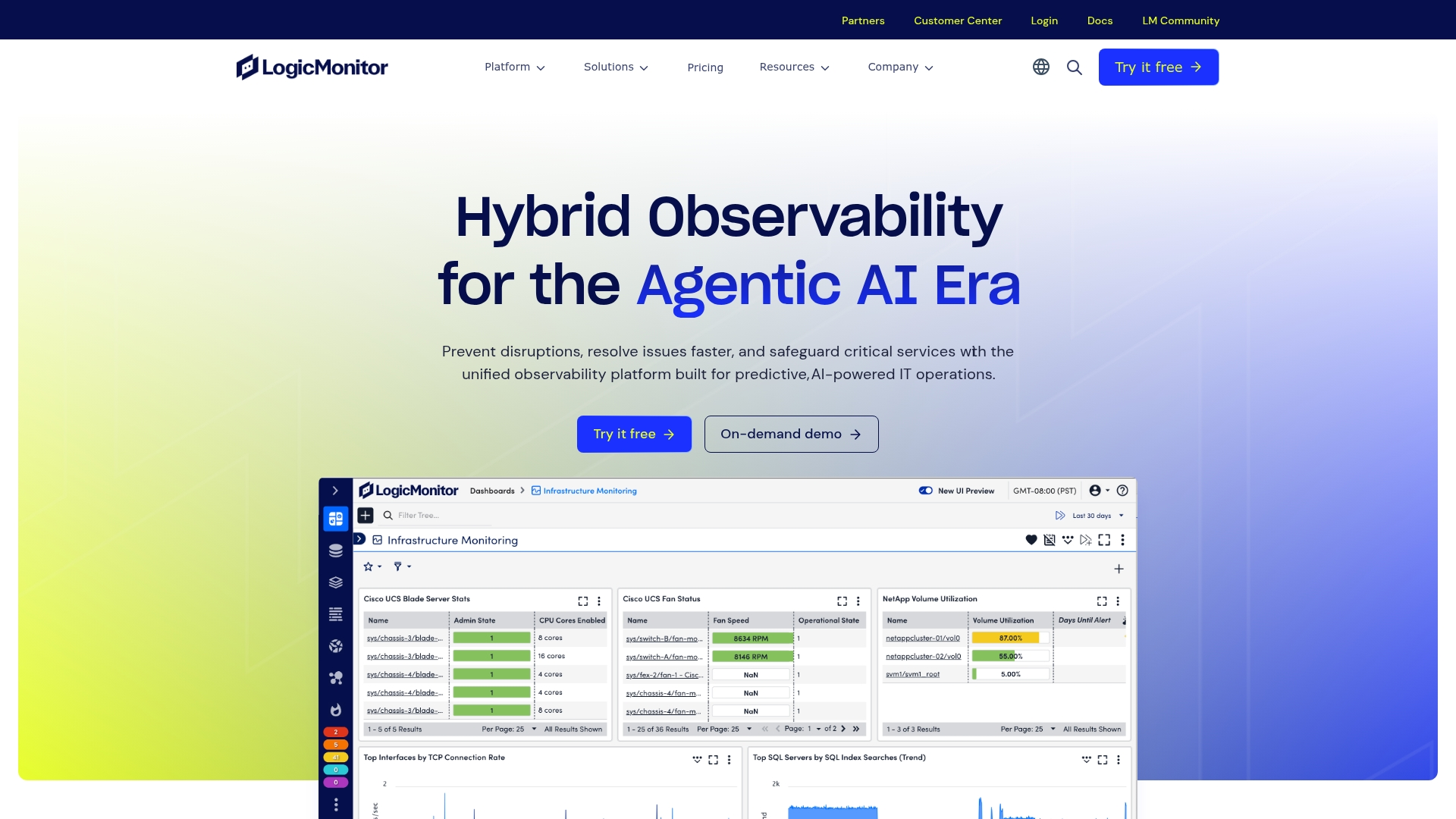
Best for: Mid-sized to large organizations managing complex hybrid infrastructures that require unified monitoring and intelligent automation.
Key features:
- Edwin AI agent provides plain-language summaries, predictive analytics, and autonomous incident detection.
- Adaptive thresholding and anomaly detection rather than static rules.
- Unified view across cloud, on-prem, containers, network devices, and storage.
Pricing:
Plans start at around $16/month per hybrid unit for infrastructure/IAAS monitoring. There is also a 30-day free trial available.
Considerations:
- Learning curve for advanced configurations may require specialized training
- Pricing may be prohibitive for smaller businesses with limited IT budgets
9. New Relic
New Relic blends full-stack observability (APM, logs, infrastructure, user experience) with built-in AIOps — anomaly detection, incident correlation and AI-powered workflows. It works well for engineering-led teams seeking unified visibility and automated insights.

Best for: DevOps, engineering and SRE teams needing telemetry, observability and intelligent incident management together.
Key features:
- Instant anomaly detection across applications, services, and logs with automatic correlation of related alerts into single issues
- New Relic Grok generative AI assistant that allows natural language queries for system diagnostics and troubleshooting
- Predictive alerting with ML-driven forecasting and recommended alert conditions to identify monitoring gaps
Pricing:
Entry level starts at US $10 per full platform user/month, plus data ingestion beyond free 100 GB at around US $0.40/GB. Custom pricing with advanced features and Data Plus option available for enterprise.
Considerations:
- Platform complexity can create a steep learning curve for new users, particularly when mastering advanced features and NRQL query language
- Consumption-based pricing model may lead to unpredictable costs for organizations with variable data ingestion patterns
10. BigPanda
BigPanda offers event-correlation and incident automation built for high-alert-volume environments. Its “agentic AI” transforms thousands of monitoring events into actionable incidents, supporting large enterprises and operations centers.
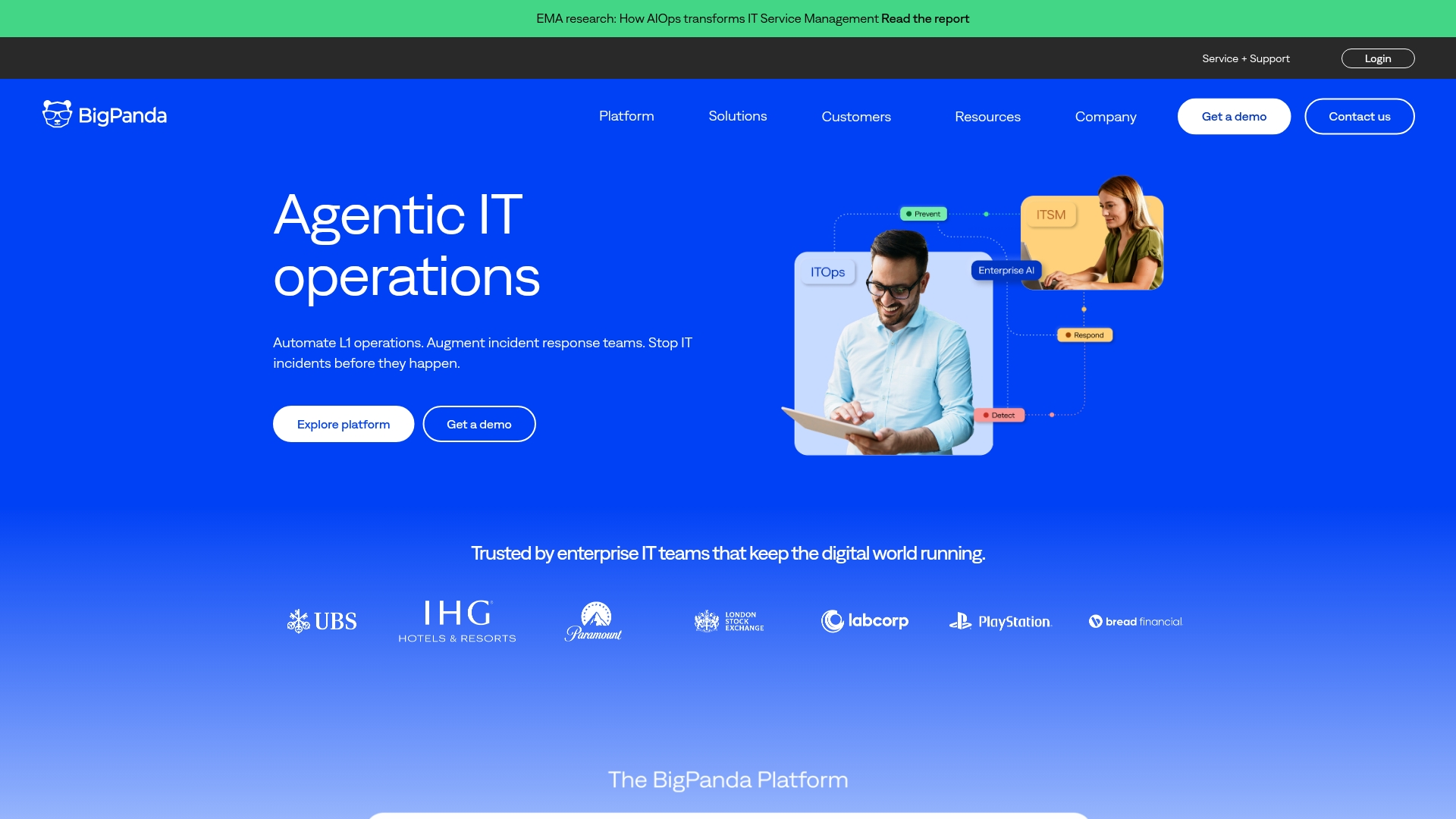
Best for: Enterprises with large volumes of alerts and fragmented monitoring stacks that need to reduce noise and streamline triage/response.
Key features:
- Transparent machine learning models (“Open Box ML”) to correlate events intelligently and root-cause at scale.
- Real-time event consolidation and enrichment from multiple monitoring, change and ticketing systems.
- LLM-powered incident summaries, root-cause suggestions and impact assessments.
- Deep integration with multiple monitoring & ITSM systems (e.g., Splunk, New Relic, ServiceNow).
Pricing:
Starts around US $6,000/year for base subscription. Custom enterprise pricing applies for larger scale.
Considerations:
- Learning curve can be steep for teams new to AI-powered incident management, requiring time investment to fully leverage the platform’s advanced correlation capabilities
- Performance may slow when integrating with extensive infrastructure and numerous external monitoring tools, particularly in very large enterprise environments
11. OpsRamp
OpsRamp delivers unified IT operations management with AIOps-driven alert correlation, automation, and service mapping for hybrid and multi-cloud environments. Acquired by HPE, the platform provides a single workspace for monitoring, managing, and remediating incidents across complex infrastructures.
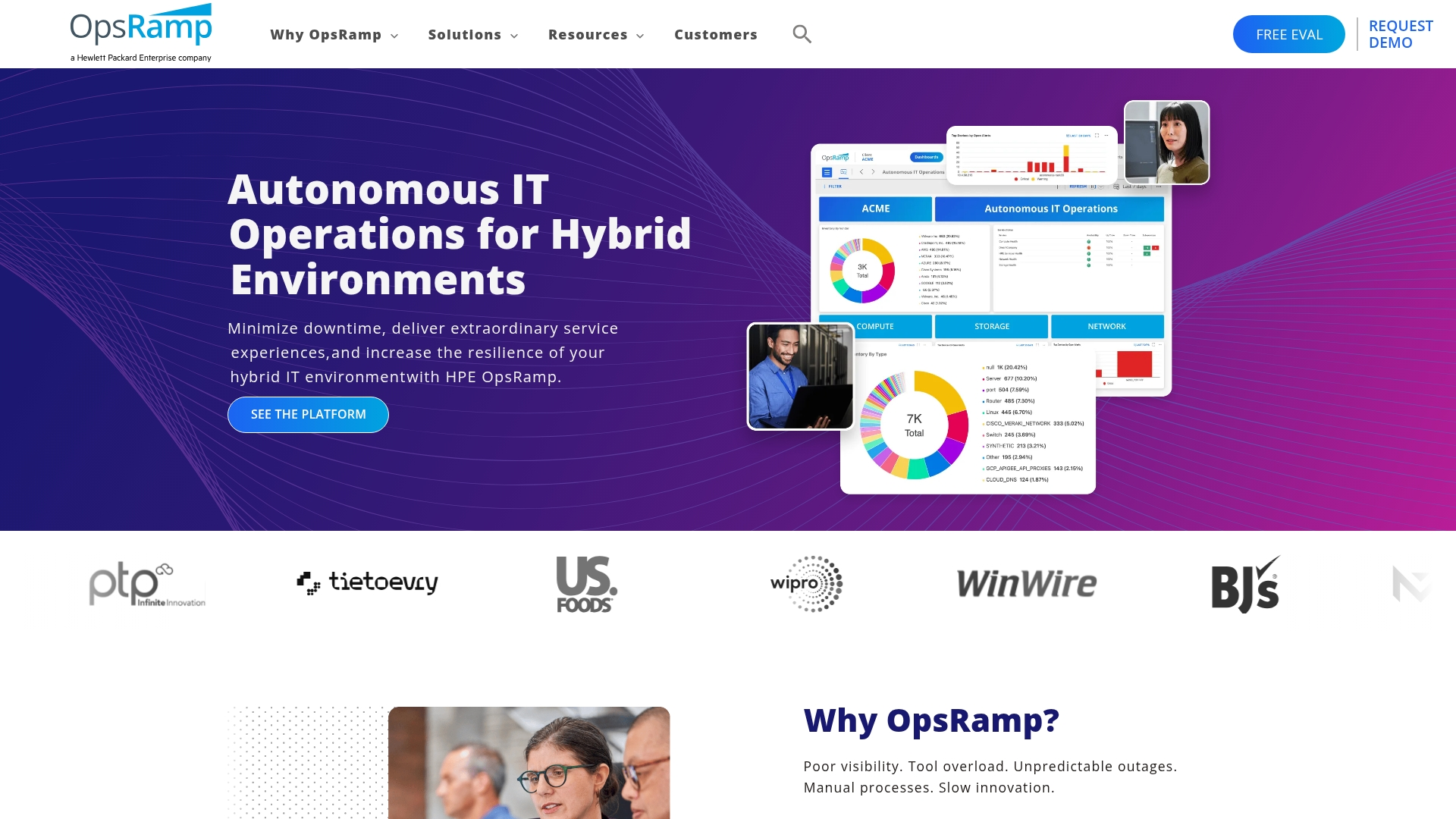
Best for: Enterprises and managed service providers (MSPs) managing hybrid, distributed, or multi-tenant IT environments.
Key features:
- Machine-learning event correlation that identifies root causes and suppresses noise.
- Automated remediation workflows that resolve recurring incidents without manual input.
- Dynamic service mapping and dependency visualization to show business impact.
- Integration with ITSM tools like ServiceNow, BMC Helix, and Jira Service Management.
- Policy-based alert routing and escalation workflows.
Pricing:
OpsRamp offers custom pricing based on subscription length (1–5 years), deployment model, and usage.
Considerations:
- Implementation complexity requires teams with data science and machine learning expertise
- Dashboard performance can lag when handling very large datasets in enterprise environments
12. ScienceLogic SL1
ScienceLogic SL1 combines observability, automation, and AIOps to help enterprises manage hybrid and multi-cloud environments. It automatically discovers assets, maps dependencies, and applies machine learning to reduce incident noise and mean time to resolution.
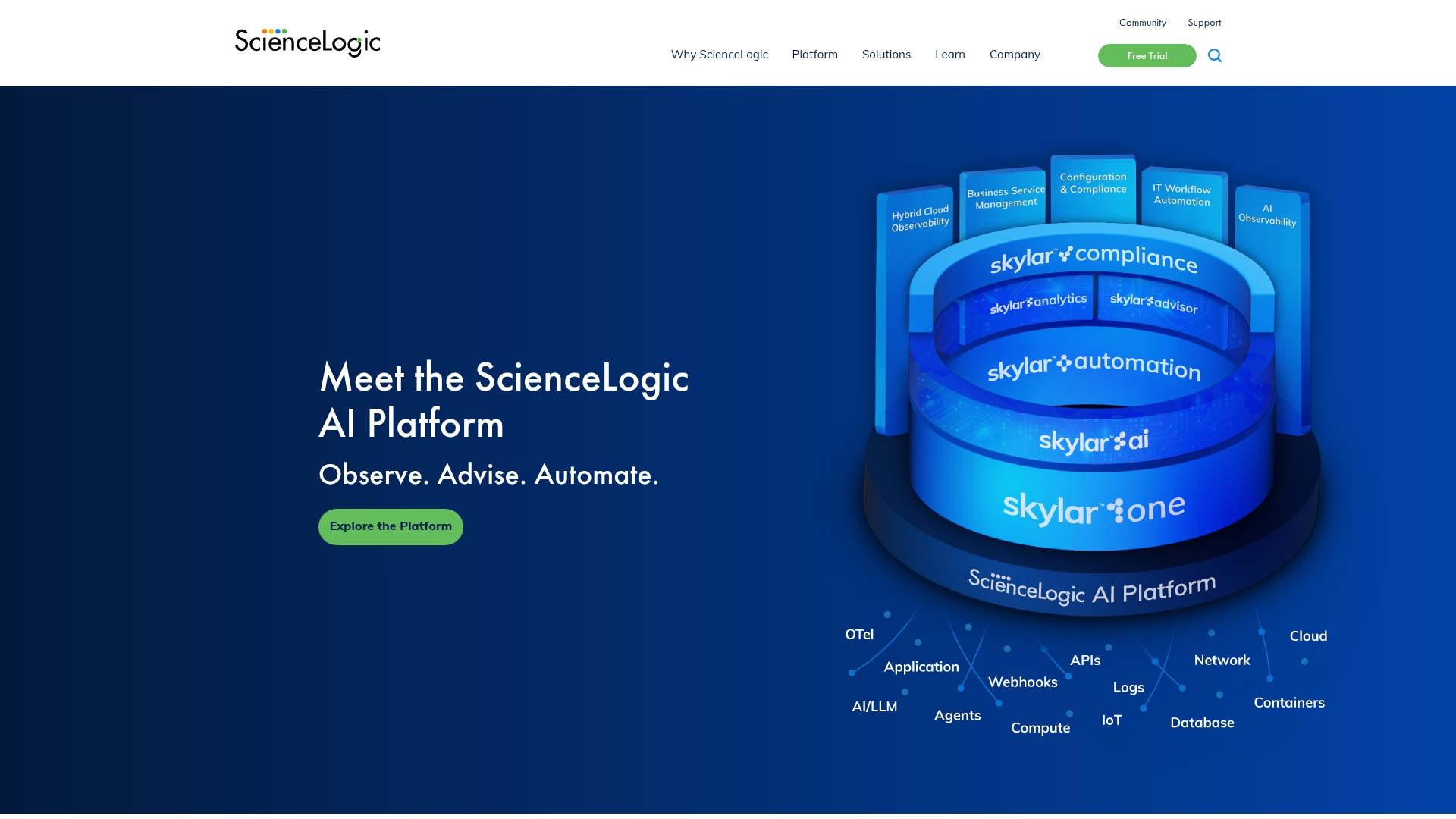
Best for: Enterprises needing a unified AIOps platform that connects monitoring, CMDB, and automation in one view.
Key features:
- Automated discovery and dependency mapping that provides real-time context across hybrid cloud environments
- Behavioral correlation using AI/ML to diagnose service disruptions by understanding normal operational patterns
- Low-code automation (PowerFlow) for creating workflows and integrating with ITSM platforms like ServiceNow
Pricing:
Plans start around US $5 per device/month for standard monitoring, scaling with add-ons like compliance, workflow automation, and HA support. Enterprise discounts and trials are available.
Considerations:
- Users report a steep learning curve and complexity in initial setup and administrative tasks
- Per-device pricing model can become expensive for large-scale deployments without volume discounts
13. PagerDuty
PagerDuty applies AIOps intelligence to digital operations management, helping teams cut through alert noise and automate incident response. It’s built for organizations needing fast, coordinated reactions across development, operations, and on-call teams.

Best for: DevOps and SRE teams managing high alert volumes and requiring reliable on-call and incident automation.
Key features:
- AI-powered event grouping and noise reduction that identifies true incidents.
- Root-cause analysis trained on 15 years of operational data.
- Event-driven automation workflows for auto-remediation and service recovery.
- 700+ integrations with monitoring, ITSM, and communication tools.
- Advanced add-ons for analytics, automation, and generative AI assistance.
Pricing:
Free tier available for small teams. Paid plans start at US $25 per user/month (Professional) and scale to Enterprise with AIOps and automation add-ons starting around US $699/month. Annual billing offers discounts.
Considerations:
- AIOps capabilities require an additional subscription on top of base incident management plans, which can significantly increase total cost of ownership
- The platform’s effectiveness depends heavily on data quality and volume, potentially limiting value for smaller organizations with fewer incidents
14. Datadog
Datadog brings unified observability and AIOps together with intelligent alert correlation, anomaly detection, and automated remediation. It’s widely adopted by DevOps and engineering teams for monitoring applications, infrastructure, and logs at scale.
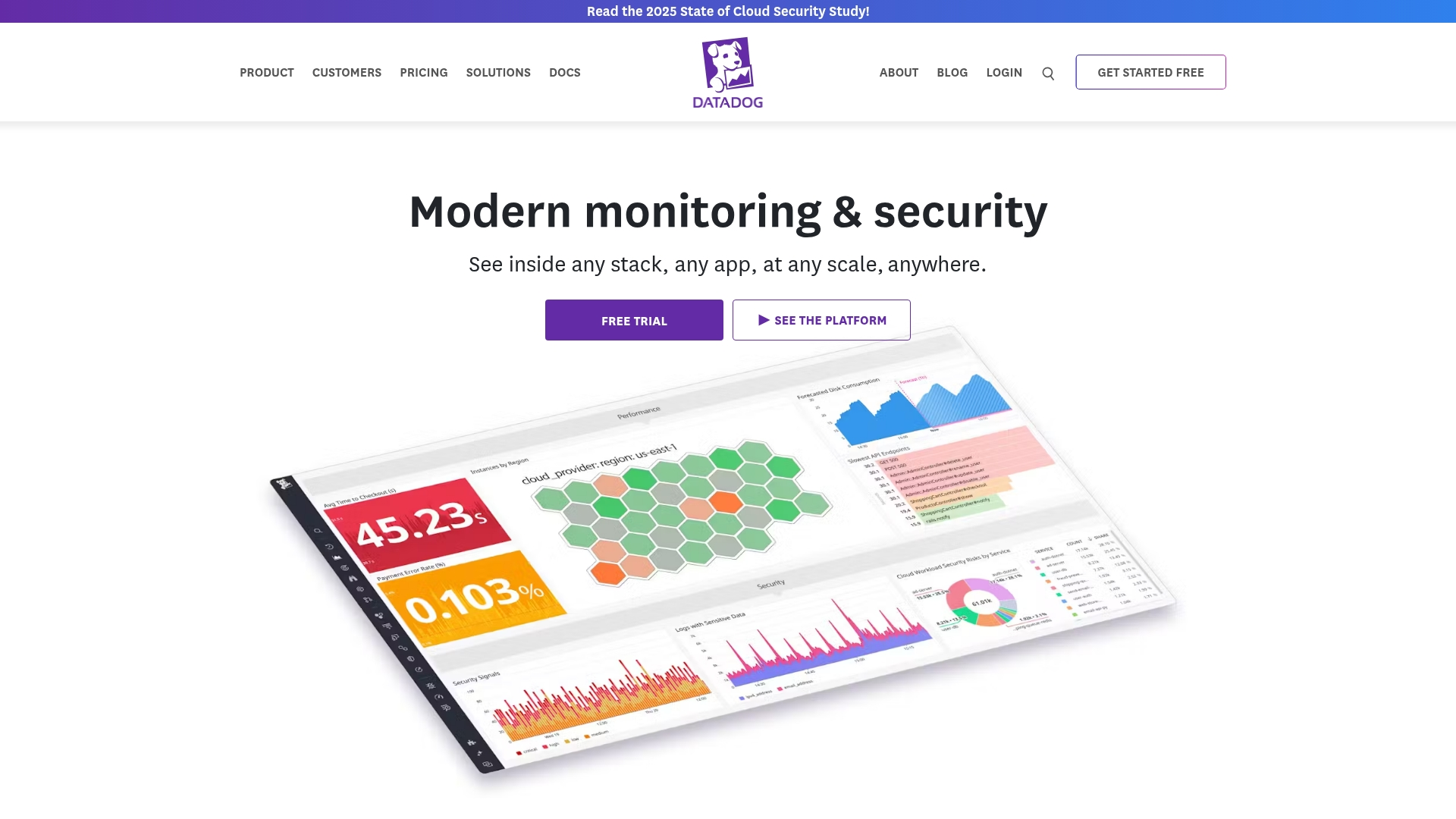
Best for: Mid-to-large enterprises managing multi-cloud environments or microservices needing real-time insight and automation.
Key features:
- Watchdog AI engine automatically detects anomalies and performance issues.
- Event Management consolidates and correlates alerts across sources.
- Bits AI assistant supports natural-language troubleshooting and query generation.
- Custom dashboards for tracing, metrics, logs, and user experience data.
- Native integrations for CI/CD pipelines, cloud services, and collaboration tools.
Pricing:
Infrastructure Monitoring starts at US $15 per host/month. Enterprise plans add APM, Log Management, and Event Management at modular rates with volume discounts and trials available.
Considerations:
- Pricing can become significant for large-scale deployments with high data volumes, especially when ingesting comprehensive observability data
- The platform’s extensive feature set may present a steep learning curve for new users, requiring investment in training and onboarding
15. Zabbix
Zabbix offers open-source monitoring and AIOps-ready automation capabilities for organizations that prefer a customizable, cost-effective solution. It combines anomaly detection, forecasting, and root-cause analysis in a highly configurable environment.
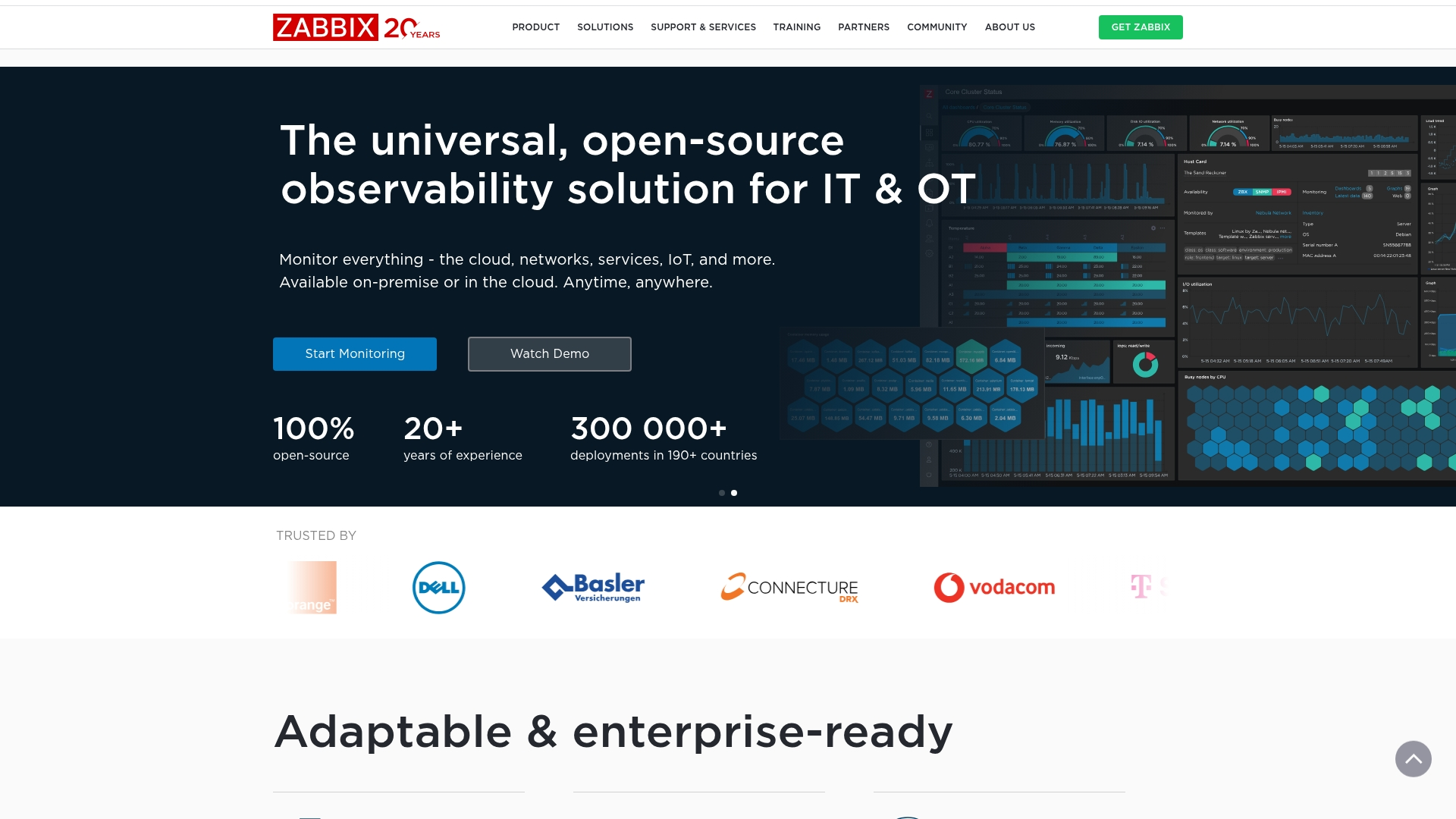
Best for: Technically skilled teams seeking open-source flexibility and budget-friendly observability.
Key features:
- Predictive functions to forecast metric thresholds and anticipate issues.
- Machine-learning-based anomaly detection and event correlation.
- Root-cause and dependency analysis for faster incident response.
- Integrations with cloud providers, ticketing systems, and chat tools.
- Multi-tenant and distributed monitoring architecture.
Pricing:
Support subscriptions begin around US $50/month for 50 NVPS (new values per second). Free open-source deployment available. Enterprise tiers scale by monitored volume and SLA needs.
Considerations:
- Native AIOps capabilities are less advanced than dedicated proprietary platforms, often requiring third-party integrations for sophisticated AI features
- Steep learning curve and complex configuration requirements can lead to false positives without proper tuning and technical expertise
AIOps in action
monday service brings AIOps capabilities directly into daily workflows, giving teams the context and automation they need to maintain consistent uptime. It monitors performance, detects anomalies, and alerts the right people before disruptions occur. AI-driven insights help teams act quickly, reduce manual investigation, and keep critical systems running smoothly.
When an incident happens, monday service analyzes operational data across tools in real time to identify the root cause and recommend the next step. Teams resolve issues faster and gain a clearer picture of system health. The result is reliable, proactive service management that keeps operations moving forward.
How to choose the right AIOps platform
An effective AIOps platform should integrate seamlessly with your existing stack and adapt to the way your teams already work. monday service connects data, people, and automation in one workspace—simplifying collaboration and helping every department stay aligned.
Instead of managing multiple tools, teams can visualize all performance insights in one place. monday service delivers intelligent automation, built-in dashboards, and cross-department visibility that accelerate problem detection and resolution.
As your organization grows, monday service scales effortlessly. Its low-code flexibility and AI capabilities support complex environments while remaining intuitive for every user, from IT operations to HR and facilities.
Strengthen your service operations with AI-powered monday service
monday service transforms reactive IT operations into a proactive, data-driven discipline. AI prioritizes requests, routes tickets to the right person, and automates recurring tasks. Teams focus on high-impact projects that improve reliability and service quality.
Every workflow becomes faster and more transparent. AI delivers real-time insights, helping teams prevent incidents, reduce alert noise, and maintain performance across the organization.
Start using monday service to connect people, data, and automation — and turn IT operations into a true business advantage.
Try monday serviceFAQs
What problems does AIOps actually solve?
AIOps addresses alert overload, delayed response times, and visibility gaps across complex IT environments. It analyzes data from multiple sources to detect issues early, correlate related alerts, and automate resolution steps. Teams gain control over performance, reduce repetitive work, and spend more time improving systems rather than reacting to outages.
How long does it take to implement an AIOps solution?
Implementation time depends on data complexity and integrations. Many cloud-based platforms can start producing insights within weeks once connected to monitoring and service tools. Full adoption—where the AI learns your environment and begins automating responses—typically happens within a few months.
What skills are needed to manage AIOps day to day?
Teams don’t need data science expertise to use AIOps effectively. Most modern platforms include pre-trained models that continuously adapt to your environment. IT professionals manage configurations, set policies, and review AI-generated insights, while the platform handles data analysis automatically.
How does AIOps work with existing monitoring and service tools?
AIOps complements existing tools rather than replacing them. It aggregates data from monitoring, logging, and service management systems, correlating events to provide a single operational view. This unified layer helps teams act faster without switching between multiple dashboards.
What should we look for in an AIOps platform?
Look for scalability, strong integrations, and an intuitive interface. Prioritize solutions that provide clear, actionable insights instead of raw data. Reliable automation, transparency in how AI decisions are made, and flexible deployment options are also key for long-term adoption.
How can AIOps improve team productivity?
AIOps automates repetitive diagnostic work and filters out low-value alerts. Teams spend less time triaging and more time on optimization, project planning, and innovation. It also improves collaboration by keeping service, development, and operations teams aligned with shared, real-time data.
Does AIOps support compliance and security requirements?
Yes. Leading platforms include encryption, audit logging, and access controls that align with major frameworks like SOC 2, ISO 27001, and GDPR. They also provide role-based permissions and regional data hosting to meet organizational and regulatory needs. Always verify a vendor’s certifications and documentation during evaluation.
Is AIOps adoption expensive or resource-intensive?
Cloud-based and modular pricing models make AIOps accessible to teams of all sizes. The primary investment is in integration and training rather than infrastructure. As automation increases efficiency, most organizations see long-term savings in time and operational costs.
 Get started
Get started 

